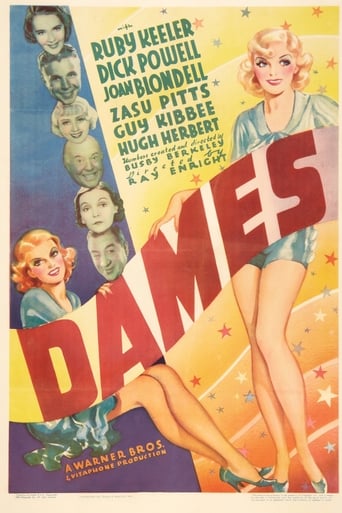

Absolutely Fantastic
... View MoreIt's not great by any means, but it's a pretty good movie that didn't leave me filled with regret for investing time in it.
... View MoreI am only giving this movie a 1 for the great cast, though I can't imagine what any of them were thinking. This movie was horrible
... View MoreThis is a must-see and one of the best documentaries - and films - of this year.
... View MoreWith 25 minutes to go, I opened up a browser window to IMDb and went ahead and gave this film a 3-star rating. Yes, it had the origin of the classic song "I Only Had Eyes for You", but was otherwise mediocre most of the time, and anywhere from inane or offensive the rest of the time. Even an ear-catching bit of very non-timeless dialog like, "I can do what I want! I'm free, white, and 21!" Worst of all, with 25 minutes to go, no vintage dazzling Berkeley choreography. It was obvious why it was not to be mentioned in the same breath as "42nd Street", "Footlight Parade", or "Gold Diggers of 1933."Then...wow! Berkeley choreography/cinematography goes into overdrive! Some of the wackiest, most beautiful visually stunning pieces ever featuring Berkeley's movement, Ruby Keeler's face (several of them, in fact), some amazing dissolves, and the beautiful black and white images dominate the last third of the film. I wish the first hour wasn't so underwhelming, but the rest of it does its best to make up for it!
... View MoreHis 1933 blockbuster 42ND STREET focuses on serious issues backstage of performers and show creators. The following year he used three members of its principal cast, Guy Kibbee, Dick Powell and Ruby Keeeler as three of his leads in DAMES casting other familiar faces from Hugh Herbert to Joan Blondell to Zasu Pitts. This is a screwball comedy few of the scenes played straight its ending ending having nothing to do with tying up the threads of the plot. The brilliance of this film in my opinion is the way Berkley softens the true presentation of the hard life and desperation of show business people of the era by having a longer production number of the finished show filmed than in most of his films and having his two well known character actors, Hugh and ZaSu filming much of their familiar comic shtick to soften the blow of the reality of the scenes of the hard times of the performers.
... View MoreFrom 1929 until the late 1930s, Hollywood made a ton of films that followed a very similar pattern. There was a thin story that was more an explanation and excuse for the HUGE production numbers to come. This plot almost always had to do with something that threatened to cancel the 'big show'. Despite many thinking Busby Berkeley only directed films like this or that all these films were Berkeley movies, they weren't. But the ones with the wildest production numbers so often did end up being his films--and he always seemed to try to outdo himself--resulting in some VERY crazy films! Seen today, people are often in shock at these numbers--with huge swimming pools, dozens and dozens of pretty dancing girls, sparklers, enormous sets and the like. But, even if you don't like them, you have to admit it took a lot of work and talent to direct and choreograph these peculiar films! The thing that threatens to stop the show is a blue-nose (Hugh Herbert)---a moralist who threatens to pull financing from the show because it features, uh-oh,...dancing girls! While Herbert is best an acquired taste (one I have never managed to acquire), Guy Kibbee was his usual fun self. As for the singers and dancers, the very familiar Dick Powell and Ruby Keeler are the leads. None of the story particularly excited me, but there were a few nice songs (such as "You Ought To Be in Pictures") and the production numbers were...well...crazy and complicated. None of this is in the least bit innovative or different from a couple dozen other films, but it is pleasant and well-made. While not nearly the quality of the better musicals like "Footlight Parade" or "42nd Street", if you like the genre this is a pleasant, if predictable, film.
... View MoreThis was the fifth musical in two years since Warners revitalized the genre with 42nd Street and the fact is that whatever your preference the chances are this will probably satisfy it; for example if you're a fan of songwriters then you have not only the highly successful team of Harry Warren and Al Dubin but also an arguably less successful team in Sammy Fain and Irving Kahal (although we shouldn't forget that they came up with two smash hits, I'll Be Seeing You and I Can Dream, Can't I) in one show (Right This Way, 1938) and for good measure old timer Mort Dixon weighs in with a number. If, on the other hand you're an aficionado of character actors look no further because here you'll find F. Hugh Herbert, Guy Kibbee and Zazu Pitts strutting their stuff and as if that weren't enough you have the great Joan Blondell wisecracking her way through the script and unleashing a production number to boot. On the other hand you will have to endure the Singing Sweat Gland, Dick Powell, to say nothing of the clod-hopping Ruby Keeler. Ah well, you win some, you lose some.
... View More